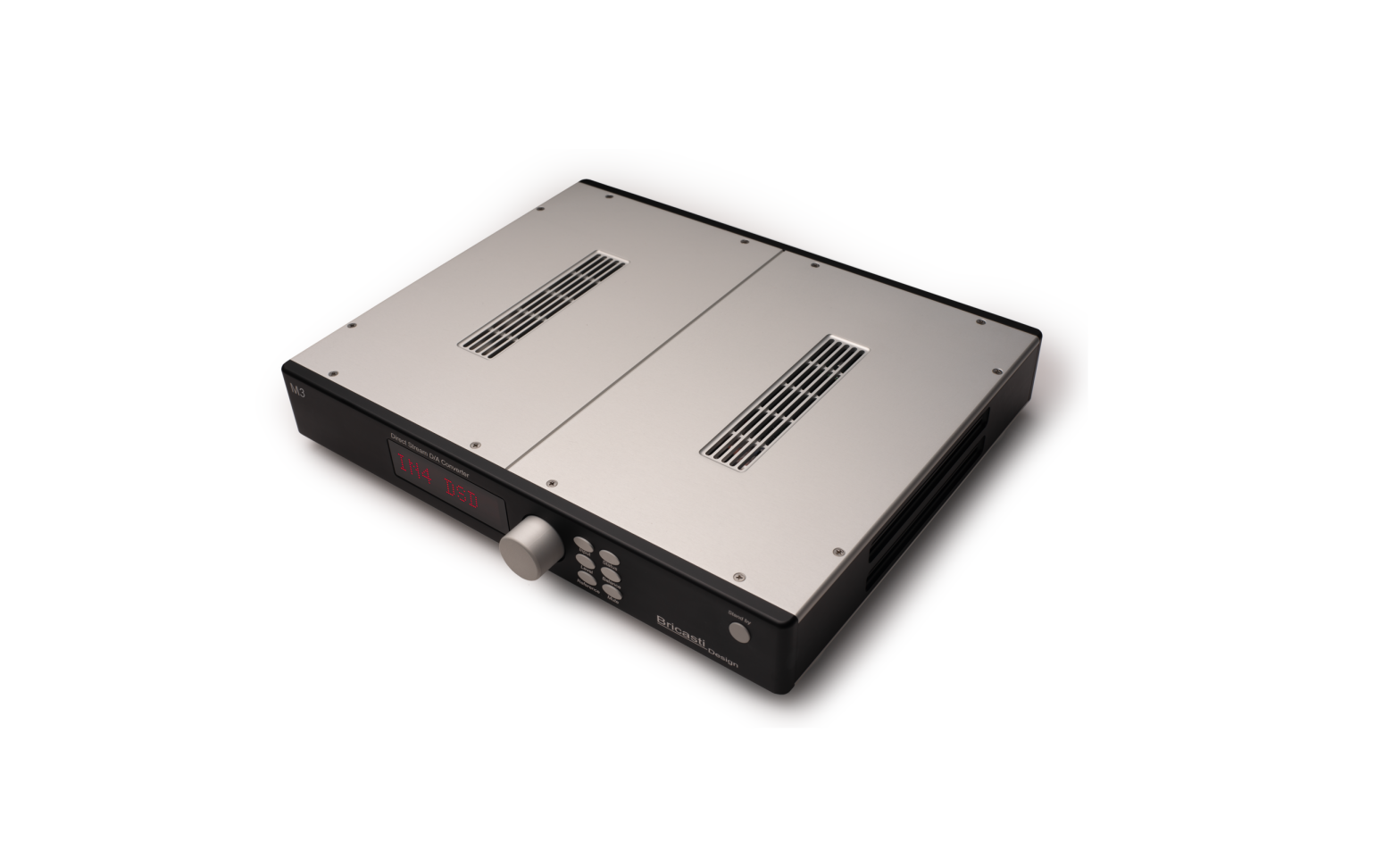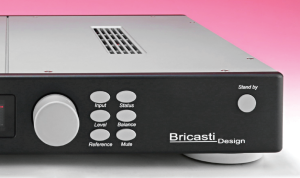M3H Dac
REVIEWHI-FIWORLD
American Beauty
The beautifully made Bricasti M3H DAC and head phone amp from America may be easy on the eye,but is its beauty more than skin deep? Chris Frank land finds out.
I admit to not knowing much about Bricasti before laying hands on its M3H DAC with headphone amp.Yet, this American company’s musical credentials are impressive. Bricasti was founded in 2004 by Brian Zolner and DSP software engineer Casey Dowdell a pro-
audio company once described as “the godfather of digital reverb”. The M7 reverb processor was Bricasti’s first studio product and importer SCV has been slowly building Bricasti’s presence in the UK hi-fi market since the M3 joined the flagship M1 at the CanJam show last July.
The standard M3 DAC sells for £5,399, but the M3H is fitted with the optional headphone amp, adding £679 to the price.The M3H is well constructed. Weighing around 4.5kg, the 64mm high by 356mm wide by 287mm deep case is machined from solid aluminium sections. It uses two fully
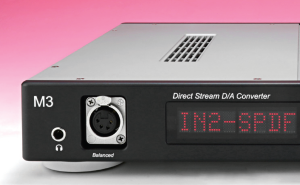
differential conversion channels, each with its own Analogue Devices AD1955 chip in a mono configuration with clocking achieved by DDS (direct digital synthesis) to ensure a “pure digital signal path” without the use of sample rate converters, to help it achieve “extremely low” levels of jitter.
Independent power supplies have been fitted for analogue and digital processing sections to help prevent digital noise from entering the analogue chain. There is native DSD playback through AES or SPDIF inputs using its own proprietary one-bit analogue converter.The USB interface supports sample rates up to 384kHz/24bit PCM and DSD256 via DoP.
To replay DSD files from a computer, you will need to use a media player such as JRiver or Audirvana. In my case, I simply plugged a USB drive containing my DSD files into a Pro-Ject Stream Box S2 Ultra (see review in September issue) and used that for playback.The front panel sports a volume control, display and six buttons to select input, level, status, balance and mute. A `reference’ option allows you to store your settings. On the far left there are balanced (XLR) and unbalanced headphone outputs.
The rear panel provides analogue outputs balanced via XLR and unbalanced via phono and digital inputs via S/PDIF: electrical (phono), AES/EBU (XLR), Toslink optical, and also USB. There is also an RJ45 network socket. The volume control allows the M3H to drive an external power amplifier.Bricasti say their headphone circuit operates in true balanced mode, with four drivers, one for each positive and negative leg of the left and right signal, and is said to provide a “balanced path from the output of the DAC to the headphones”.
I fed the M3H from an Audio Note CD4.1x CD player. The Bricasti then fed an Audio Note Tonmeister integrated valve amp driving Audio Note AN-J LX Hemp speakers and alternatively Focal Chora 816s (review September 2020 issue).The M3H offers two digital filters for PCM (CD) playback. Differences were small, but I marginally preferred Linear to Minimum Phase.
First impressions of the M3H were good. On Van Morrison’s Perfect Fit from the Days Like This CD, his challenging vocals were well presented and articulate, backing singers were well separated and the horn section had plenty of pizazz. The bass line could have been a little fuller, but on balance the M3H sounded very good.On Ben Sidran’s Sunny Side of the Street, the weighty bass line of this excellent recording was well conveyed with a good `walk’, while his stylish, jazzy vocals were articulate and detailed. All in all, the M3H appeared free from any major flaws.Next I tried a couple of DSD files. On Stevie Wonder’s Master Blaster from Hotter than July the M3H captured his unique vocal style well and got a firm grip on the track’s solid, pumping rhythms, with a good snap to drums and percussion.On It’s Too Late from Carol King’s Tapestry, the M3H imbued her vocals and piano with great presence and delicacy, while the bass line was tuneful and percussion well defined and separated.So how was it on headphones?
To find out I hooked up Focal’s excellent Stellias.I tried them in both balanced and unbalanced mode and there was no doubt the balanced output was markedly superior in sound quality.The M3H acquitted itself masterfully with the Stellias. On James Taylor’s Mexico, his guitar had great note shape, attack and body,
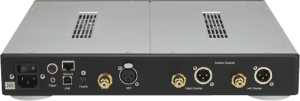
DigitalS/PDIFinputs(atleft)areAES/EBU (XLR),electrical(phono),optical(Toslink). ThereisalsoUSBforcomputer. Balanced(XLR)andunbalancedanalogue outputsareprovided(atright).
![]()
Analogue and digital circuits have their own in dependent linear power supplies,fed by the circular to roidal transformers seen here.
his vocals were excellent, drums were dynamic and the backing vocals from David Crosby and Graham Nash were nicely defined.Sax ace Kenny G’s G Bop meanwhile moved along nicely with good weight to its bouncy bass line, great definition to his mellow, yet incisive, soprano sax and a fluid syncopation to the percussion line.
CONCLUSION
The Bricasti M3H impressed me greatly. CD and DSD playback were excellent and it gave a strong performance both on its analogue line output and through headphones. It is a very capable performer.
MEASURED PERFORMANCE
With output Level set to reference 0dB, giving 2V from the RCA phono socket analogue outputs and 4V from the balanced XLR socket outputs, Dynamic Range (EIAJ) measured 120dB from the former and a high 123dB from XLR. The AES/EBU digital S/PDIF input also measured 123dB. These are high values, putting the M3 up with the best, if not ahead. It uses an Analogue Devices AD1955 DAC (2002) whose spec quotes 123dB dynamic range, so it meets spec.Output can be doubled by turning the level control to +6dB but doing this degrades dynamic range slightly, rather than increasing it as in Chord Electronics DACs. Best to use 0dB with the M3.The headphone output delivers 8V maximum, way above 1V or so needed for most headphones (for shattering volume), so plenty of leeway here. Dynamic Range measured 122dB excellent for headphones.Distortion and noise levels were very low. With 24/96 distortion came in at
0.015% (-60dB) up with the best. As always, distortion from CD (16/44.1) was 0.2%, due to 16bit quantisation noise.Frequency response extended to 43kHz with 192kHz sample rate digital (fed in via the S/PDIF electrical connector) our analysis shows, rolling off slowly to the 96kHz theoretical upper limit. The filters did not alter this. The S/PDIF optical input (Toslink) connector managed 96kHz maximum; with 176.4kHz and 192kHz sample rates it fell silent, where most DACs have Toslink connectors and receivers able to handle these rates.The Bricasti measured well in all areas, but inability to process no higher than 96kHz sample rate via optical input is a drawback. NK
Frequency response
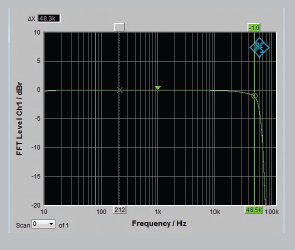
DISTORTION
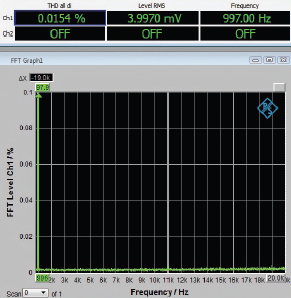
BRICASTI M3H £6,078OUTSTANDING – amongst the bestVERDICT Performed well on CD and DSD playback and offered excellent sound quality on headphones too.FOR – great-sounding DAC – drives headphones effortlessly – great sound on DSD playback – can be used as a preampAGAINST – no remote control as standard – optical input can only process 96kHzSCV Distribution +44 (0)330 122 2500 www.scvdistribution.co.uk
References
[xyz-ips snippet=”download-snippet”]

